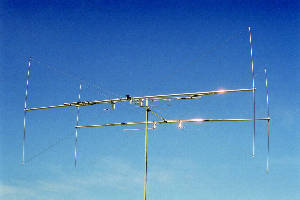no. of visits Last updated: 3/02/04 buckmaster callsign server QRZ callsign server E-mail me (remove nospam) home
best viewed at 1024*768
|
DXing from a small gardenAntennasWe've all seen the pictures of geezers who can put up humongous beams on 200 foot towers. Unfortunately for most of us this is simply not possible. Most Hams in the UK are handicapped by small gardens (50 foot or less), or sometimes no garden at all in which to put antennas up! So what do you do if you want to work reasonable DX on the HF bands? Whilst it is true that sometimes you can work all over the place with the odd piece of wire slung up at 30 feet or so, or a low dipole (less than 1/2 wave over ground), most of the time such a setup will be found to be poorly inadequate. 20 Metres and aboveFor the bands above and including 20 metres it is desirable to have some kind of beam although reasonable results can be obtained from a multiband vertical. Unless you live in the clear on a hill, you would be well advised to mount the antenna on the roof, or on a pole as far off the ground as possible. Of course a ground mounted vertical will work, but no where near as well as one that is mounted up higher. Listen to some of the eastern European stations who have verticals mounted on top of tower block flats and you'll see what I mean about the effectiveness of mounting a vertical on the roof! With a ground mounted vertical you have to put a lot of effort into burying radials (more on that later), whereas with a roof mounted vertical you need as few as three radials. A ground mounted vertical will suffer signal attenuation on both transmit and receive from nearby objects such as trees and buildings, and has a much higher potential to cause interference to domestic appliances in nearby houses. Beams in small gardensSo what about beams? Well of course most HF beams tend to be on the large side and often it is not practical to erect one in a small garden. There are various minibeams on the market although most of these can perform like rotatable dummy loads and often will not outperform a horizontal dipole mounted at the same height. Perhaps the two most effective minibeam designs are those manufactured by Force 9 and Butternut. I myself have used a butternut for many years with excellent results. The Butternut HF5B minibeam covers 20-10m including 17 and 12m (dipole on 17m). Each element is 12 feet long and there are no traps for tuning which means that losses are reduced. Vertical spreaders are incorporated in each element to provide a wider 2:1 SWR bandwidths than would not normally be obtained with a beam of this size (see diagram). The turning radius is only 7 feet, and it can be mounted on a standard aluminium pole attached to the house. Quoted gain figures are around 5dBd (15-10m), and 3dBd (20m). For optimum performance you need to get the beam 33 feet above ground at a minimum (1/2 wave on 20 metres).
Be aware that most commercial minibeams are not much cheaper than their full size counterparts (at least not in the UK)! For the homebrew there are also plenty of antennas for small gardens outlined in the excellent 'HF antennas for all locations' by G6XN, including some mini-beams that should in theory produce acceptable performance such as the VK2ABQ beam for 10/15/20 metre bands. |

 Butternut HF5B
Butternut HF5B